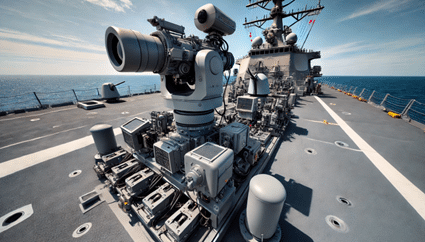Introduction to directed energy laser weapon systems
Directed energy Laser weapon systems harness high Laser power delivered at a concentrated point to produce variety of damage levels and even, in some cases, the complete destruction of the target. Many nations, including the United States, actively explore their deployment and seek to incorporate them on the battlefield.
Unlike traditional ammunition, directed energy laser weapon systems offer potential cost savings per shot, and can theoretically be regarded as a high laser power system with unlimited firing capacity. However, uncertainties remain regarding their lifetime and stability over the long term. Additionally, adverse environmental conditions, such as haze and mist, can diminish the effectiveness of certain directed energy Laser weapon systems.
The Challenges of high-power Laser weapon system
Despite advancements achieved over many years of research, several obstacles hinder the widespread adoption of directed energy laser weapon systems. These challenges include maintaining laser stability over extended periods, ensuring high damage thresholds, a narrow bandwidth and precision to meet lethality requirements. Achieving high laser power density on target often involves combining multiple laser sources coherently while minimizing beam divergence and maximizing efficiency
Until recently, these challenges posed significant barriers to achieving high laser power. However, with the adoption of Diffractive Optical Elements (DOEs), some critical bottlenecks can be overcome.
Diffractive Optics applications for Directed energy weapon systems
Diffractive Optical Elements meet rigorous requirements including:
• High Laser Damage Threshold
• Near absolute angular accuracy – there are effectively no tolerances to deflection or splitting angles, a critical consideration for beam combining and targeting at a distance.
• Durability- DOEs are monolithic, etched glass components that can withstand harsh environmental conditions
• Size and weight: DOEs are flat windows that are compact, low-weight, and can have low thickness, thus are easy to integrate into high power laser systems at defense and aerospace applications.
Holo/Or has some unique solutions for directed energy laser weapon system, including custom collimated beam shaping elements, diffractive prism arrays, diffractive lens arrays and diffractive beam splitter elements. Holo/Or can combine multiple optical functions into a single element, and can manufacture elements with different sub-apertures, each having its own optical function. We can also create phases to compensate for phase errors of other optical components such as lenses and mirrors, including correction of aberrations, tilt and defocus.
Check out our custom solutions, and feel free to contact us for more details
Conclusion
Diffractive optical elements play a significant role in the coherent beam combining of directed energy laser weapon systems. These elements, including beam shapers, beam splitters, and other DOEs, are flat, thin, and exhibit high laser damage thresholds (LDT) and accuracy. They enable the generation of high laser power by coherently combining input laser beams and distributing power according to pre-designed specifications. Overall, these diffractive elements are invaluable in Laser weapon systems
TL; DR – Q&A SUMMARY
What are diffractive optical elements?
Diffractive Optical Elements (DOEs), sometimes referred to as digital diffractive optics, are phase relief elements that use micro-structures to alter the phase of the light propagated through them, and thus manipulate it in various ways to create shapes and light patterns that are either impossible to achieve with different methods using refractive optics, or require very complex, bulky and expensive optical components and / or systems.
How are Diffractive optical elements used in directed energy and other defense systems?
Holo/Or can combine multiple optical functions into a single element, and can manufacture elements with different sub-apertures, each having it’s own optical function. This is highly useful for correction of deflection angles or aberrations.
what are the requirements for using diffractive optics in Laser weapon systems?
The main requirements are for the DOEs to withstand high LDT, transmit with high efficiency, and apply the needed phase compensation for coherent combining.



